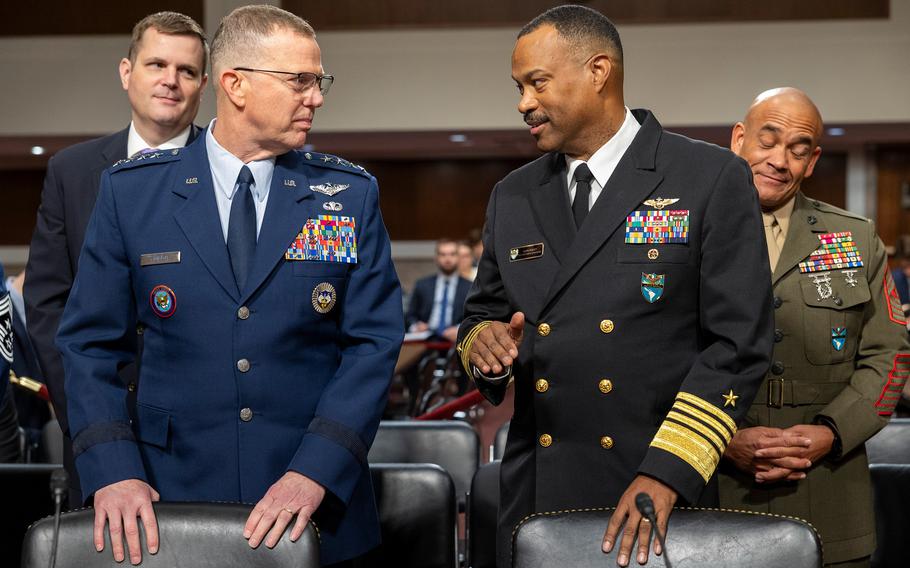
Air Force Gen. Gregory Guillot, commander of U.S. Northern Command, left, and Adm. Alvin Holsey, commander of U.S. Southern Command, speak Thursday, Feb. 13, 2025, before a Senate Committee on Armed Services hearing. (Eric Kayne/Stars and Stripes)
Two commanders in charge of enhanced military operations along the U.S.-Mexico border were unable Thursday to give senators clear answers about the financial and training costs for using active-duty troops to monitor the border, fly deported migrants out of the country and detain them at Guantanamo.
Instead, Adm. Alvin Holsey, commander of the U.S. Southern Command, and Gen. Gregory Guillot, commander of U.S. Northern Command, described continually evolving plans with costs spread between multiple agencies and military services. Neither offered a clear answer on overall estimates or budgets.
They fielded questions and concerns from members of the Senate Armed Services Committee on the bulked-up military effort along the southwest border since President Trump took office for his second term in January.
Trump on Jan. 20 — his first day back in office — signed executive orders that have increased the number of troops supporting the Department of Homeland Security at the border with Mexico to about 5,000 with the expectation of adding more, Guillot said. There had been about 2,500 National Guard members deployed for border security.
Trump also ordered the military begin flying deported migrants out of the country and sent 700 troops down to Naval Base Guantanamo in Cuba to manage and improve an existing detention facility for migrants. Historically, the Coast Guard has delivered migrants to the base for short stays as they await deportation.
Senators questioned Thursday whether using troops for these jobs drastically increases costs and cuts into the training and preparation for them to fight and win wars. Holsey’s command oversees the work at Guantanamo while Guillot’s oversees much of the remaining border work.
Sen. Elizabeth Warren, D-Mass., cited a 2021 Government Accountability Office review that found Pentagon estimations of the cost of the border mission at that time were misleading.
“When the first Trump administration deployed troops to the border, it pegged the cost at $1 billion over three years, but the GAO found that the Department of Defense estimates were ‘not reliable and excluded significant costs,’” she said.
In reports to Congress, the Pentagon missed more than half the actual total cost for entire fiscal years, Warren said.
“Now, DOD estimates that this new border deployment will cost almost $1 billion over the next eight months, but that may be another underestimate,” she said. “So, Gen. Guillot, you are overseeing the border deployment, does underestimating the cost of an operation put future missions and future readiness at risk?”
Guillot responded he “assumed so,” and the burden of budgeting is not on his command but lies with the Pentagon comptroller and the military services.
“I’m concerned that we’re going to see the same problem that we saw the last time, big costs and little transparency and accountability,” Warren said.
Troops on the border deployment are only getting about 20% of the training that they would if they were at their home station except for pilots and some infantry whose work at the border lines up with their military job, Guillot said.
“If they are conducting [border] missions that are outside their normal specialty,” he said. “We have a series of five workdays, one training day and then one day off each week.”
The border work for troops has included hanging barbed wire along already existing barriers, detection and monitoring, and vehicle maintenance.
Guillot also did not answer questions about the costs of deportation flights.
Some senators at the hearing said the use of military aircraft to deport migrants can cost about $30,000 an hour — three to four times as much as chartering flights has cost Homeland Security in the past. Guillot directed those questions to U.S. Transportation Command, which is responsible for the deportation flights that have transported migrants to countries including Guatemala, Ecuador and India.
Military aircraft also flew about 100 migrants to Guantanamo, where they are being held awaiting deportation. Troops deployed there are tasked with providing supplies, food, care, shelter and medical support to the people detained there.
Trump has said he would like to house up 30,000 people at the facility, which would require enhancements and more personnel. Sen. Tammy Duckworth, D-Ill., questioned how that would occur and what the cost would be. A 2017 military construction estimate for the migrant facility stated each guard sent there for nine months costs about $100,000, she said.
“At this time, we’re doing a phased approach. So right now, we’ll have capability for about 2,500 cots, and that plan is going to go up if we continue to phase it in. We haven’t decided that yet. I’m waiting for further direction,” Holsey said. “We’re working with DHS to understand the flow of migrants. We won’t go to 30,000 unless we know that migrant flow will come. So we’re waiting at this point.”
The basic cost of running the facility annually is about $100 million, he said. That includes the prison for suspected terrorists, the migrant detention facility and the rotation of troops to work as the site.
The military services are bearing the cost to flow troops to Guantanamo right now, Holsey said. Duckworth asked what priorities were being unfunded as a result, but the admiral said he could not answer.
The two officers continued to answer questions in a classified session that was closed to the public.